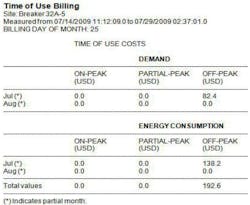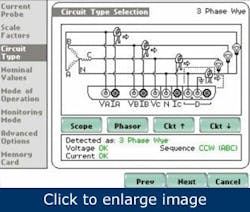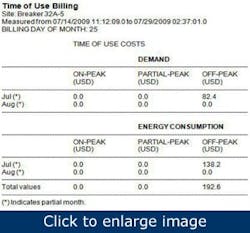Effective electrical energy audits track the right variables and provide actionable results
Facility professionals are finding savings opportunities by better understanding when, where and how energy is being used. It’s the necessary first step in managing utility bills. Powerful handheld instruments are ideal for facility energy studies and carbon footprint calculations, taking forward/reverse energy measurements for grid-tied alternative energy systems, and for complying with public and private-sector energy initiatives.
As the world’s largest energy consumer, the United States used around 100 quadrillion BTUs, or 105 exajoules, of energy in 2005 — three times what it was back in 1950. The U.S. Department of Energy claims that industrial and commercial buildings account for nearly 50% of that, to the tune of more than $200 billion annually. Little wonder that recent years have seen the proliferation of a bewildering array of public and private-sector energy initiatives designed to micromanage the process of increasing energy efficiency, reducing greenhouse gas emissions, mandating more stringent conservation measures and driving greater reliance on renewable energy resources.
Facility energy performance
Whether the goal is to comply with government legislation, qualify for Energy Star, LEED, Green Globes, or other rating, or simply save energy and cut cost, the tool most often used to benchmark facility energy performance, the starting point, is the energy audit. The purpose of such studies is a comprehensive evaluation of the actual performance of a plant’s systems and equipment compared to its optimal designed performance level.
The difference between observed performance and best practices is the twilight zone where potential energy and cost savings reside. Plant performance audits are vital to strong energy management programs, without which the continuous improvements of energy efficiency and its resultant cost savings are difficult to characterize. Energy audits are an extremely useful way to:
- Identify actions for improving energy performance
- Prioritize projects
- Track progress.
At the operations level, it’s not unusual for large industrial and commercial power consumers to see electric bills carrying demand charges as high as 50% of the facility’s actual consumption costs. As an offset, load shedding, peak shaving, installing more efficient lighting and other energy management strategies go far toward helping plant professionals reduce demand penalties. However, before any of these strategies can be implemented, it’s necessary to gain an exact picture of how, when and where the energy is being used.
Conduct audits
[pullquote]As a cost-effective means for doing that, an energy audit conducted at the front end of the process helps you understand energy usage and identify areas where mitigation strategies can be implemented to cut operating costs.
As part of a strategic corporate energy management program, regular plant energy audits can be self-assessments conducted by company staff, external audits conducted by contracted energy service professionals or a combination of both. Regardless of the audit type, the audit team seems to be most effective when represented by members offering varied expertise, such as maintenance experts, systems managers and process engineers. Outside experts are especially useful for providing specific technical expertise lacking in the company.
Know what to measure
Energy audits come in many forms and can range from simple applications that monitor a single device or machine to complex monitoring of an entire campus. Regardless of a facility’s energy load, most energy audits have much in common. The most important variables to measure when analyzing electrical energy are typically voltage (V), current (I), Watts (W), volt-amperes (VA), volt-amperes reactive (VAR) and power factor (PF). Recorded over time, these basic variables can provide the necessary information for a complete energy profile.
Voltage and current measurements are used to compute the other variables. The variables can be viewed instantaneously using a variety of instruments, but the key benefit of using an energy analyzer is its ability to record and trend variables over time. Energy analyzers also compute the demand and energy that utilities use for billing. Low-cost energy analyzers offer the functionality and flexibility to perform simple-to-sophisticated energy audits that can be exported into popular software programs.
What to look for in an energy analyzer
Today’s energy analyzers are more powerful and cost-effective than ever before. Because even low-cost analyzers include the accessories and software needed to conduct a complete and user-friendly energy audit, energy analyzers are now within reach for any facilities that need to manage ever-rising energy costs.
What an energy-measuring instrument measures and computes is important, but how it measures can be critical. For example, some inexpensive, low-resolution instruments might measure the basic variables, but they can miss data and thereby produce misleading measurements.
Effective energy-analyzing instruments provide a sampling rate appropriate for the application while also capturing continuous readings. Power analyzers typically define sampling rate as the number of measurements taken per AC (60/50Hz) cycle. Because the instrument produces a digital representation of the analog voltage and current being measured, it’s generally desirable to use an instrument that provides a higher number of samples per cycle, thus resulting in more accurate data collection.
Look for an energy analyzer that can measure more than just the basic power variables, because more advanced variables might be required to also help understand the quality of the electrical supply, including voltage and current total harmonic distortion (THD), transformer derating factor (TDF) and crest factor (CF). Additionally, with the advent of alternative-energy applications, variables such as forward and reverse energy that record the flow of power to and from the grid often are required.
Instrument connections
Connecting an energy analyzer properly is essential, especially considering the sometimes complex three-phase circuits. Proper voltage and current connections are necessary for proper readings. It can’t be stressed enough to follow all appropriate safety procedures and manufacturer’s instructions closely when making instrument connections. Such circuit connections can pose a danger and only qualified personnel should make instrument connections.
Consider the three-phase wye circuit (Figure 1). To measure the circuit’s total power, the energy analyzer sums the individual power in each phase. The instrument’s wattmeter measures each phase, although the total number of wattmeters required varies by circuit type. A wattmeter requires both a voltage and current circuit connection and measurement. Voltage is always measured between a “hot” wire and a reference, with the most common reference, when available, being a neutral wire. Voltage usually is connected directly to the circuit in low voltage systems instead of through potential transformers or transducers. It’s important to ensure the analyzer can measure the voltage levels in use safely.
Figure 1. The analyzer’s online help can show how to make the connections properly.
Current usually is measured using current transformers. These are available in many types ranging from rigid clamps to adaptable flexible units. Regardless of the type, it’s necessary that the current transformer be sized for the application and has a range appropriate to the circuit. If the current being measured falls outside this range, the measurements might be inaccurate. Each current transformer will have an arrow or other indicator showing the direction of current flow. All current transformer connections must have the arrow in the same direction and pointing toward the load. Connecting the analyzer depends on the circuit type, so it’s important to make that determination first.
The survey
Details of the survey can vary greatly according to the application. The usual energy audit goal is to determine the system’s energy profile. Regardless of application, it helps to know some information about what’s being monitored, such as the type of load, process or facility. These details are essential for determining the energy survey’s duration.
Monitor several cycles of the load being audited to obtain a complete picture of its energy profile. For example, an industrial process that cycles (start to finish) every 15 minutes might need monitoring only for an hour to capture multiple cycles and to find out what is usual or typical for that load. An office building with a 24-hour cycle might require a longer survey, perhaps a week or more, to determine a typical energy profile. A survey replicating a utility bill might require monitoring for multiple utility billing cycles lasting several months.
Reports and results
Most energy analyzer software provides printed or electronic reports that summarize and report the result of an energy survey, but the range of capabilities and flexibility vary widely (Figure 2). Reporting requirements vary greatly by application, with some requiring little detail while others might require formal reports on a client’s company letterhead.
Figure 2. Typical energy analyzer software enables printed or electronic reports.
Many applications require advanced PC-based reporting for e-mail or printing. To that end, some instruments enable quick and easy reporting that includes a built-in energy audit report along with the ability to export the information to other software.
The good news for facility maintenance and engineering personnel is that powerful, cost-effective handheld electrical energy and power demand analyzers specifically designed for conducting facility energy audits and power demand studies are now on the market. These tools are a good way to gather, record and report where, when and how much electricity the facility uses. Applications in industrial, commercial and institutional facilities include energy/cost reduction programs, alternative energy monitoring and power/harmonic studies.
With the growing emphasis on green facilities, instruments provide the ability to record both forward and reverse energy, an essential measurement in grid-tied alternative energy system analysis. Another important consideration in the LEED process, these instruments also can be used for certifying a facility’s energy consumption and carbon footprint.
Ross Ignall is director of product management at Dranetz (www.dranetz.com). Contact him at [email protected] and (732) 248-4325.


